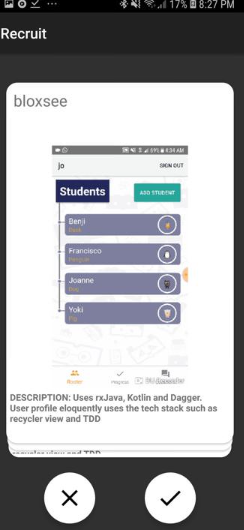SocialGood Hackathon Roundup
This month I’ve participated in a company-sponsored Hackathon with the theme of social good, attempting to solve social problems with technology. There were about 80 participants many were students, graduates, and industry professionals. We were also supported by mentors and corporate sponsors to help us use their tools for our code and application.
Challenge:
The issue that our team wanted to tackle was to reduce unconscious bias when it comes to hiring. Unconscious biases we wanted to limit are education background, years of experience, and college GPA. These are really great qualifiers for an application, but some things such as personal circumstances or social economic factors create a disadvantage for the qualified applicant that might be a good fit a position. We wanted to promote equal opportunity in this way.
Solution:
Mobile App aimed at connecting job positions to qualified candidates using NLU (Natural Language Understanding) The recruiter/hiring manager would only see the project match and not the name of the person. The recruiter gets matched with a list of names and may opt to reduce the list before sending out an email notification to set up a behavior interview. So, what’s the difference between what we’re offering and linkedin? The difference that the process is like a blind audition. The recruiter/hiring manager won’t see a name. The potential of this solution is leveraging this concept in internal hiring. For example, use this to match qualified applicants that would have been overlooked.
Lessons and concepts Learned:
Industry and Executive Perspectives on implementing Diversity When it comes to hiring and retaining diverse employees, you really have to be intentional and even have a pipeline when it comes to a target market you want to reach out to. Unconscious biases are everywhere and we can consciously mitigate them. Make sure you have access to the tools! We’ve assumed it was all set up, but that was not necessarily true. Teamwork and building a culture quickly This was huge because we’re expected to form, storm, norm, and perform within days. Typically, it would take a long time to get to know team members before working together effectively. You don’t necessarily need to be a programmer Design and Implementing new Tools I was able to observe the strategy design from a developer’s perspective. We were able to create an app from end to end. Solve a problem, not the product. It is really tempting to create an application and focus on the UI, but not solve the initial challenge. It’s ok to take risks for the sake of exercise. That’s one of the main points of a hackathon. Solving problems with unconventional solutions and you might solve a problem that you weren’t trying to solve before. Modeling and Machine Learning tools IBM Watson leveraging Red Node Amazon Comprehend. Data quality practices
Looking ahead:
I want to refine our logic or at least prove to a higher certainty that the matching algorithm can work. I want to apply these concepts in my current job role and company imagine solving problems that are known for long periods of time to be solved over the weekend. I want to host or at least support a hackathon locally. A growing demand/trend are hackathon as a service. I’ve networked with organizers and could seek them for support and advice.

As a reference, here is our GitHub repo and DEV post of the hackathon.
Enjoy Reading This Article?
Here are some more articles you might like to read next: